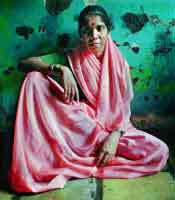
VALON JA VARJON HUONEET
 Elokuva kertoo kahden mumbailaisen bordellin arjesta ja siellä työskentelevistä naisista.
Intian kaupungeissa työskentelee arviolta miljoona prostituoitua, maaseudulla 1,4 miljoonaa lisää. Maassa on 80 miljoonaa uutta sukupuoliteitse tarttunutta tautitapausta vuosittain.
Elokuva kertoo kahden mumbailaisen bordellin arjesta ja siellä työskentelevistä naisista.
Intian kaupungeissa työskentelee arviolta miljoona prostituoitua, maaseudulla 1,4 miljoonaa lisää. Maassa on 80 miljoonaa uutta sukupuoliteitse tarttunutta tautitapausta vuosittain.
Tätä taustaa vasten mumbailaisen Vinayn työ näyttää toivottomalta. Hän vierailee vapaaehtoisena prostituoitujen luona, vie heille lääkkeitä, jakaa valistusta AIDSista, rohkaisee lopettamaan alkoholin ja lähettää naisia lapsineen ilmaiseen sairaalaan.
Ilman Vinayta John Websterin ohjaama Valon ja varjon huoneet olisi voinut jäädä tekemättä. Vinayhin luotetaan ja hänen ansiostaan kuvausryhmä pääsi seuraamaan kahden bordellin päivittäistä elämää.
Toisen bordellin omistaa Sakhubai, ammattiinsa 12-vuotiaana huijattu lähes viisikymppinen nainen, joka kaikesta huolimatta löytää aina jotakin hyvää sanottavaa. Hän on lainanantajien ja korokiskureiden kierteessä ja elämä on hänen bordellissaan rauhallista.
Eloisampaa ja iloisempaa on elokuvan toisessa bordellissa. Siellä työskentelee kolme naista ja kolme eunukkia. Vaikka heidän vitsinsä ovat ronskimpia, hiljentyvät hekin miettimään elämän perusasioita: mistä saada ruokaa ja kuka heidän ruumiistaan huolehtii.
Jotkut bordellien naisista ovat vain 12-vuotiaita, useimmat vähän vanhempia.
Vaikka naiset ovatkin yhteiskuntansa hyväksikäyttämiä ja hylkäämiä, on heillä kuitenkin ylpeytensä. Ja toivoa.
- Ohjaaja: John Webster
- Tuotanto: Millennium Film, 2000
In English In English In English
ROOMS OF SHADOW AND LIGHT
 The Saheli project is run from the rooms of the Indian Organisation, a two-room office on the premises of the J.J. Hospital in Bombay. The actual programme is based on a three-tier system of peer leaders:
The Saheli project is run from the rooms of the Indian Organisation, a two-room office on the premises of the J.J. Hospital in Bombay. The actual programme is based on a three-tier system of peer leaders: - A Saheli (friend) from among the sex workers for every 25 girls.
- A Tai (sister) from among the brothel managers for 10 Sahelis
- A Bai (mother) from the brothel owners for each major area.
The responsibilities assigned to the peer leaders is the education of the sex workers on disease prevention, the distribution of condoms and the escorting of sick girls to the clinics.
Each morning a Saheli worker, a driver, a social worker and a doctor meet at the office. They load the Mobile Clinic with condoms and set off to a predetermined area in the red-light districts. Twice daily, the minibus drives to the dingy streets, parks and waits. Presently other Sahelis will arrive to collect the condoms handed out of cardboard boxes from the back of the van, and take them back to the brothels for further distribution. Sex workers with problems, medical or social, will arrive for consultation with the doctor or the social worker. They receive free medication.
The key to the Saheli project's success is both financial and social. A direct incentive incentive is given in the form of $ p.m. for each Saheli for an hour's daily work. A Tai receives $18 p.m. for part time work and $ 45 for full time.
But there is another, more important benefit: condoms are primarily used not because it protects the user from AIDS, but because it protects from more contracting other STDs. After all, when faced with the problems of daily survival, contracting a disease that will kill you sometime in the distant future is hardly likely to be taken that seriously. But the use of condoms on a daily basis, and coupled with free medicines to combat infections, means that the prostitute can actually save money, rather than spend in on the treatment of disease. For the first time the prostitute have the possibility to plan for the future, for themselves and their children. For the fist time there is the opportunity to think of a better life.
The Sahelis well understand the importance of their work. This gives their work a strong sense of purpose as well as a tremendous sense of pride.
- Director: John Webster
- Production: Millennium Film, 2000

Päivitys: 5.2.2001 U.E.